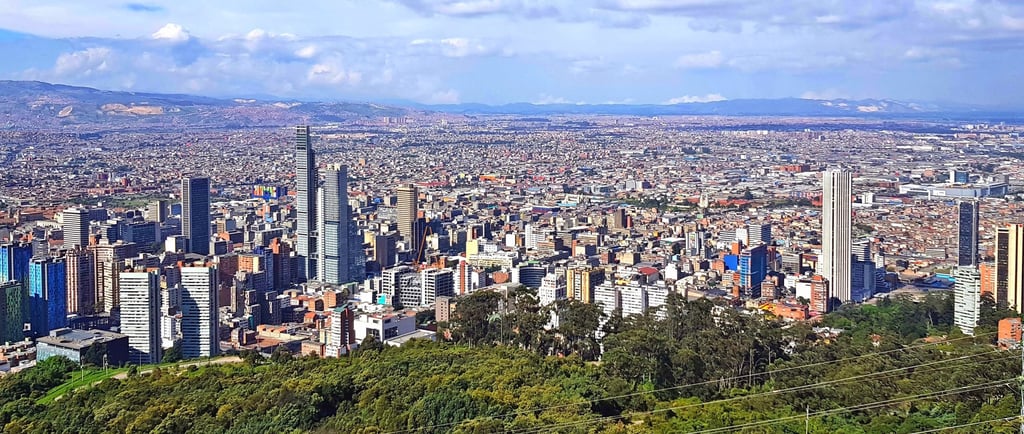Bogotá – Altitude of Stories
Explore Bogotá, a city high in the Andes where every street, mural, and mountain view tells a story of culture, resilience, and rhythm.
DESTINATIONS
Jetsclusive
6/30/20254 min read


Bogotá – Altitude of Stories
Perched 2,640 meters above sea level, Bogotá is a city where altitude weaves into every aspect of life and culture. The Colombian capital doesn't just rest atop the Andes, it thrives under thin air, cooler temperatures, and a climate that colors daily routines. Here, mountain mist meets colonial charm and innovation, making Bogotá one of the world’s highest and most fascinating urban centers. Every block and every heartbeat beats a little differently in Bogotá—and the stories it tells are shaped by altitude as much as by its people.
Living at 2,640 Meters: How Altitude Shapes Daily Life in Bogotá
Living high in the Andes redefines daily rhythms, diets, and even how people move and build. The city’s unique elevation creates both challenges and charms for its more than 8 million residents and countless newcomers.
Understanding Bogotá’s Altitude and Climate
Bogotá rises 2,640 meters (8,660 feet) above sea level, making it the highest major city in the world with such a large population. This high plateau in the Eastern Cordillera of the Andes produces a cool yet temperate climate—thanks to thinner air and stable temperatures.
Temperatures hover between 8°C and 20°C (46°F-68°F) all year, with mild variations.
Diurnal variation means chilly mornings and evenings but comfortable afternoons.
You’ll see dense fog drifting through neighborhoods—especially in the rainy season, which stretches April to November.
Frequent overcast days create the city’s trademark moody ambiance.
Environmental challenges are ever-present. Rapid urban growth has led to habitat loss and puts pressure on water supplies drawn from Andean páramos. Air quality varies, and pollution from vehicles and industry is a persistent issue.
Compare Private Jet Pricing To Bogota Here Powered By Villiers Jets - Trusted by 1000+ flyers worldwide
Physical Effects and Acclimatization for Residents and Visitors
Altitude doesn’t just shape the skyline, it shapes lungs and hearts. The thinner air holds about one-third less oxygen than at sea level, making every breath count.
Common Symptoms for Newcomers:
Headaches
Shortness of breath with even mild exertion
Fatigue and occasional nausea
Dehydration and dry skin
Adaptation Tips:
Hydrate more than usual (the air dries you out)
Move slowly, especially for the first few days
Avoid heavy meals or alcohol right away
Locals may offer herbal remedies like coca tea
Some visitors notice they need less sleep but also eat less and feel full quicker. Most people adjust within a week. Long-term residents often don’t notice the altitude unless they travel to lower elevations and suddenly feel “over-oxygenated.”
People with preexisting respiratory or cardiac conditions should check with a doctor before a long stay. Altitude affects everyone differently; children and seniors may need more time to adapt.
Altitude and Urban Planning: Architecture and Mobility
Altitude and topography force Bogotá to get creative with its city planning.
Building Styles:
Thick-walled colonial houses in La Candelaria hold warmth.
High-rises are designed for wind and seismic activity.
Flat roofs are common, as snow is rare, but rain is plentiful.
City Layout:
The city sprawls along a high plateau, hemmed in by the lush Eastern Hills.
Parks and green spaces break up dense urban areas, providing breathing room (literally and figuratively).
Mobility Choices:
The TransMilenio rapid bus system moves millions daily, designed to work efficiently in thin air and on steep streets.
Bogotá’s vast network of more than 650 km of bike lanes, known as “ciclorrutas,” is one of the world’s largest and promotes pollution-free commutes.
The upcoming Bogotá Metro will further modernize city transport, though building it on uneven, hard terrain is a major engineering task.
Compare Private Jet Pricing To Bogota Here Powered By Villiers Jets - Trusted by 1000+ flyers worldwide
A High-Altitude Hub: Bogotá’s Historical and Cultural Identity
Altitude hasn’t just shaped daily routines, it’s played a starring role in Bogotá’s long and layered history. From indigenous settlements to Spanish rule and beyond, elevation has always mattered here.
From Muisca Roots to Colonial Capital
Before Bogotá was Bogotá, it was Bacatá, the heart of the Muisca Confederation. The Muisca chose this highland for its fertile soils and defensive advantages—far from mosquito-infested lowlands and tropical diseases.
Spanish colonists realized Bogotá’s strategic value almost immediately, founding their city in 1538.
The city became Colombia’s political and educational center, a legacy that continues today.
Its elevation made it both a refuge and a prize in centuries of shifting fortunes. Isolation by mountains helped preserve traditions and lent Bogotá a unique pace compared to coastal cities.
Cultural Resilience and High-Altitude Traditions
Bogotá’s culture is shaped by resilience, creativity, and adaptation to highland life.
Gastronomy:
Nothing beats a steaming bowl of ajiaco, Bogotá’s signature soup, made with chicken, potatoes, corn, and herbs native to the Andes.
Hot drinks like “chocolate santafereño” and herbal teas are daily comforts.
Fashion and Customs:
Scarves, ponchos, and heavy coats are year-round staples.
Festivals like the Festival de Teatro and Ciclovía reflect the city’s spirit—music, art, and cycling, all set against dramatic mountain backdrops.
Annual Events:
Christmas sees entire neighborhoods light up with candles and lanterns, casting a magical glow in the cool December air.
Independence Day in July brings parades and performances across the city’s plazas.
Modern Bogotá: Innovation Amid the Andes
Today’s Bogotá stands at the crossroads of heritage and progress. While its high altitude once isolated its people, it now positions Bogotá as a trend-setting metropolis.
Renowned universities and creative industries call the city home.
Urban gardens, sustainability projects, and wetland restorations work to heal the scars of rapid growth.
Social inclusion programs and the expansion of pedestrian zones connect the city’s past with a more open, green future.
Innovation thrives in these heights. Challenges, from water scarcity to air quality, spark local solutions and foster a strong sense of community.
Conclusion
Bogotá’s stories rise as high as its peaks. The city’s altitude isn’t just a number—it’s a force that shapes climate, health, traditions, and opportunity. Life at 2,640 meters means more than thin air; it means living in a place shaped by resilience, history, adaptation, and hope. Bogotá’s altitude challenges and charms in equal measure, inviting every visitor to breathe deep and discover stories found nowhere else on earth.


Luxury
Explore the world of private aviation and travel.
support@jetsclusive.net
© 2025. All rights reserved.
